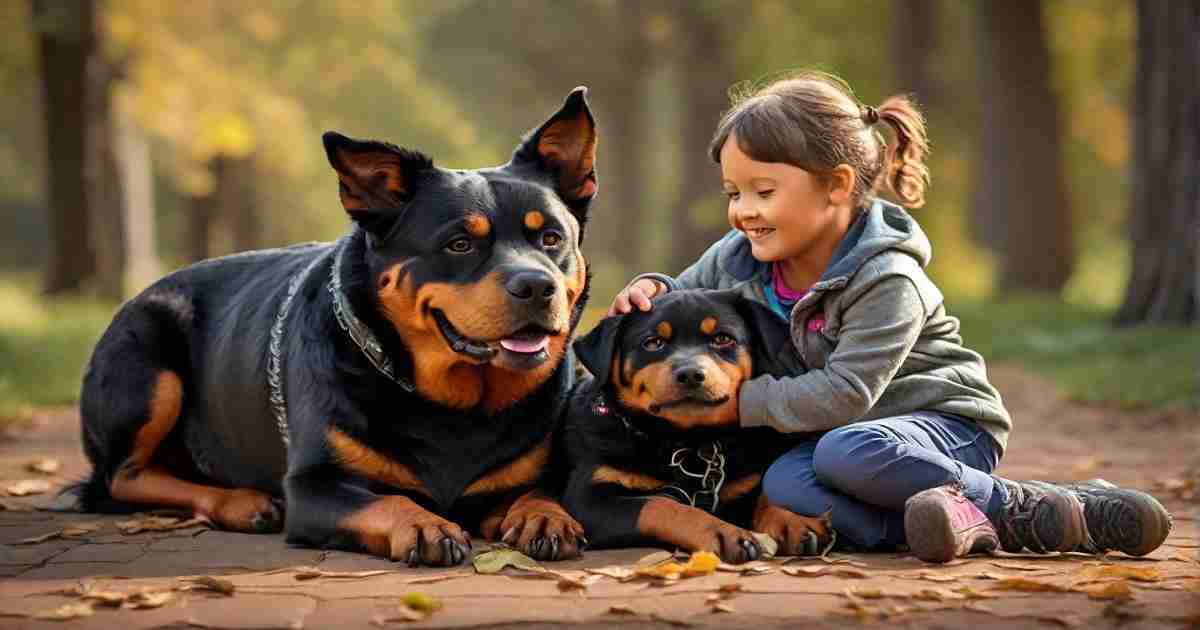The rottweiler and blue heeler mix is an increasingly popular hybrid dog that combines the best traits of two working breeds.
With the rottweiler’s strength and protective instincts and the blue heeler’s energetic herding abilities, these crossbreeds make for active, intelligent pets.
However, their high energy and strong guarding tendencies require experienced owners. This comprehensive guide dives into the history, temperament, health, care, and finding a breeder for anyone considering one of these unique mixes.
Whether you want a family pet or a working dog, insight into the rottweiler and blue heeler combo will help inform your decision.
History and Origins of the Rottweiler and Blue Heeler Mix
The Rottweiler and Blue Heeler mix is a relatively new crossbreed that combines two classic herding and working dogs – the Rottweiler originating in Germany and the Australian Cattle Dog or Blue Heeler hailing from Australia.
Origins of the Parent Breeds
- Rottweilers descend from ancient Roman drover dogs used to herd cattle for Roman legions. Their name comes from the town Rottweil in Germany where they were selectively bred as cattle dogs. They were later used as police, service, and guard dogs.
- Blue Heelers trace back to Australia’s herding dogs bred to work with cattle and sheep. They earned their name from their distinctive mottled blue coats and tendency to nip at the heels of livestock. Two breeds were crossed to create them – Smithfield Collies from Britain and native Australian Dingos.
Rise of the Rottweiler and Blue Heeler Cross
- This mix first emerged in the 1990s when demand grew for hybrid dogs. Breeders started intentionally crossing Rottweilers and Heelers.
- The aim was to blend the strength and protectiveness of the Rottweiler with the agility and energy of the Blue Heeler.
- Rottweiler and blue heeler mixes were touted as good family pets with the abilities of a working or herding dog for those seeking that combination.
- They gained popularity as companion and performance dogs for people attracted to their striking appearance and athleticism.
- While not recognized by major kennel clubs, they’ve become a niche designer dog prized by some breeders and owners.
Appearance of the Parents
- Rottweilers are large, sturdy dogs with black coats and rust-colored markings on their cheeks, legs, and chest. They have a muscular build, broad head, and docked tail.
- Blue Heelers are medium-sized, athletic dogs with a black and blue mottled coat pattern. They have erect, pointed ears and a medium-length tail left natural.
What to Expect in the Mix
Since the Rottweiler and Blue Heeler mix is a crossbreed, there’s considerable variety in size, coat, temperament, and health between individuals. Puppies can take after either parent breed or exhibit a combination of traits.
Overall, these designer dogs tend to be:
- Medium to large in size, typically 40-90 lbs
- Muscular, athletic build
- The double coat of medium-length hair
- Coat colors including black, blue, tan, red, brown
- Docked or natural tail of medium length
- Erect ears
- Life expectancy of 12-15 years
Rottweiler/Heeler mixes generally maintain strong working drives and herding instincts like both parent breeds. Their mix of protectiveness and energy makes training important starting as a pup.
Temperament and Personality of the Rottweiler and Blue Heeler Mix
The temperament of a Rottweiler and Blue Heeler cross can vary greatly depending on which parent breed’s traits are most pronounced. However, some general traits are commonly seen.
Energetic and Playful
- These designer dogs are extremely energetic, much like the working Blue Heeler parent.
- They need upwards of 60-90 minutes of vigorous exercise and play every day.
- Without sufficient activity, they are prone to destructive behavior like chewing and barking.
- Their energy makes them ideally suited for active homes or as working dogs.
Intelligent and Trainable
- Rottweilers and Heelers are both highly intelligent breeds, so their mixes pick up on training quickly.
- They respond well to firm, consistent training with positive reinforcement.
- Their smarts mean they can become bored easily without enough mental stimulation.
- Owners need to provide regular training, play, and jobs for these hybrids.
Loyal and Protective
- The strong guarding instincts of the Rottweiler make these crosses very loyal and protective of their families.
- They form close bonds with their owners and serve as great watchdogs.
- Early socialization is critical to prevent overprotectiveness or aggression toward strangers.
Potential Challenges
- Their herding background means some may nip at heels or obsessively chase moving things.
- Both parent breeds are prone to mouthiness as puppies.
- Their protective nature can cause issues with other dogs if not socialized.
- Separation anxiety is common if left alone for long periods.
With training, these well-rounded crossbreeds make devoted companions. However, their energy and guarding tendencies require an experienced owner able to provide proper leadership, activity, and socialization.
Appearance and Characteristics of the Rottweiler and Blue Heeler Mix
The Rottweiler and Blue Heeler mix can vary in appearance, especially when first-generation crosses. Some key points on their looks:
Size
- Males tend to reach 22-27 inches tall at the shoulder and weigh 55-90 pounds
- Females are usually 20-25 inches tall and weigh 45-80 pounds
- Their muscular, athletic build makes them appear slightly larger than their weight
Coat and Markings
- The double coat is of medium length like both parents
- Coat colors include black, tan, red, brown, and blue, or mixes of those shades
- Markings may be solid, bi-colored, tricolor, spotted, ticked, or mottled
- Rottie-style tan markings on the face, legs, and chest are common
- Blue or red ticking comes from the Heeler side
Head and Ears
- Broad, strong head like the Rottweiler with a slightly pointed muzzle
- Ears are often erect and triangular-shaped
- Eye color varies from amber to brown
- Black nose and lips typical of both lineages
Tail
- Tails are sometimes docked like the Rottweiler parent, but often left natural
- The natural tail is medium in length, thinner, and may have a slight curve or kink
While individual dogs vary, most carry the athleticism and working breed look of their parents. Their unique coat patterns showcase the hybrid mix. Proper socialization and training are essential given their strength and energy.
Caring for a Rottweiler and Blue Heeler Mix
Rottweiler and Blue Heeler mix have high activity needs and require dedicated owners able to provide proper training, exercise, and care.
Exercise and Activity
- Require 60+ minutes of vigorous activity daily such as running, hiking, playing fetch, or agility training.
- Access to a securely fenced yard provides space to run and play several times a day.
- Daily walks alone are insufficient – these dogs need intense exercise to prevent behavior issues.
- Ensure high activity levels until at least age 2 to avoid destructive tendencies.
Training and Socialization
- Begin obedience training and socialization immediately as a puppy.
- Use positive reinforcement training and be firm, consistent pack leader.
- Continue training regularly – their intelligence allows them to master commands quickly.
- Socialize extensively with other dogs and people to minimize overprotectiveness.
Grooming and Coat Care
- Moderate shedders – brush weekly using a slicker brush to remove loose hair.
- Bathe only when necessary using a mild dog shampoo.
- Nails should be trimmed regularly to avoid cracking or splitting.
- Clean ears weekly and brush teeth multiple times per week.
Feeding and Nutrition
- Feed a high-quality dry dog food formulated for medium/large breeds.
- Puppies need 3-4 meals per day. Adults do well with 2 meals.
- Serve 2-3 cups of food to adult dogs, adjusting for activity level.
- Avoid overfeeding as the breed is prone to weight gain.
Health and Veterinary Needs
- Schedule annual vet exams to screen for health issues like dysplasia or eye disease.
- Vaccinate as a puppy and stay current.
Providing sufficient exercise and training is key to ensuring a Rottweiler/Heeler mix stays happy and well-behaved in your home. They thrive when given plenty of activity and interaction with their family.
Health and Lifespan of the Rottweiler and Blue Heeler Cross
Rottweiler and Blue Heeler mix generally enjoy good health, having hybrid vigor from their crossed parentage. But they are prone to some potential health issues.
Lifespan
- Expected to live 12-15 years with proper care
- Larger size puts them at risk of some cancers later in life
Major Health Concerns
- Hip and elbow dysplasia – malformation of joints. Can cause arthritis if severe.
- Allergies – often food allergies resulting in skin itchiness and infections
- Bloat – life-threatening stomach twisting requiring emergency care
Minor Health Concerns
- Hypothyroidism – impaired thyroid function. Treated with medication.
- Eye issues like cataracts, progressive retinal atrophy
- Heart conditions such as subaortic stenosis, cardiomyopathy
How to Select a Healthy Puppy
- Choose reputable breeders who screen parent dogs for dysplasia, eye issues, etc.
- Ask for health clearances from the vet on both parents.
- Meet the puppy’s parents whenever possible.
- Select puppies from litters with few health problems.
- Check for signs of good health like clear eyes, clean ears, and healthy skin.
With responsible breeding, most Rottweiler/Heeler mixes enjoy longevity and good health into their senior years. Be vigilant for any emerging issues and maintain vet visits.
Full-Grown Rottweiler Blue Heeler Mix: A Powerful Package of Loyalty and Energy
The Rottweiler Blue Heeler mix, also known as the Blueweiler or the Rattle Heeler, is a captivating crossbreed resulting from the union of two strong, intelligent working dog breeds. Combining the robust physique of the Rottweiler with the herding instincts and alert nature of the Blue Heeler, these dogs are a force to be reckoned with in both appearance and personality.
Living with a Blueweiler:
- Ideal Owners: These dogs thrive in active homes with experienced owners who can provide them with the leadership, exercise, and mental stimulation they require. Apartment living can be challenging unless paired with regular outdoor activities.
- Family Life: Blueweilers can be loving companions for families with older children who can respect their boundaries. However, supervision is recommended during interactions with young children due to their size and potential herding behaviors.
- Health: Generally healthy, Blueweilers may be prone to certain conditions like hip dysplasia and elbow dysplasia inherited from their parent breeds. Regular vet checkups and responsible breeding practices are crucial for maintaining their health.
Owning a Rottweiler Blue Heeler mix is a rewarding experience, but it’s important to remember that these are not dogs for everyone. Their **powerful combination of strength, intelligence, and energy demands a dedicated owner who can provide them with the proper care and training. If you’re an active individual or family seeking a loyal and protective companion, the Blueweiler may just be the perfect canine partner for you!
Remember:
- Early socialization and training are crucial for a well-rounded Blueweiler.
- Provide ample physical and mental stimulation to keep them happy and engaged.
- Be prepared for a dog with a strong personality and potentially protective instincts.
With the right dedication and understanding, a Blueweiler can become a cherished member of your family, bringing loyalty, love, and endless entertainment into your life.
Finding a Rottweiler and Heeler Mix Puppy or Dog
Rottweiler and Blue Heeler mixes have grown in popularity, but finding a responsible breeder can still take effort. Here’s guidance on sourcing one of these hybrids:
Working with a Reputable Breeder
- Seek out breeders specializing in Rottweiler/Heeler crosses specifically. Ask breed clubs for referrals.
- Good breeders focus on health and temperament over looks alone.
- They screen parent dogs for hip dysplasia, eye disorders, and heart conditions.
- Breeders should provide health certificates for both parents.
- Expect to spend $500 to $1500+ for a Rottweiler/Heeler mix puppy.
- Be wary of breeders who charge significantly less or seem profit-focused.
Questions to Ask the Breeder
- How often do you breed litters of this cross? What is the purpose of your breeding program?
- What health and temperament testing do you perform on the parents? Can I see the results?
- How do you socialize the puppies? What is done to promote good temperament?
- What is the health history of your breeding dogs? Any issues I should know about?
- Will you take back dogs if an owner can’t keep them later on?
Adopting a Rescue or Shelter
- Consider providing a home to an adult Rottweiler/Heeler in need through a rescue group or shelter.
- Petfinder, Adoptapet, and breed-specific rescues are good resources for finding adoptables.
- An adult dog’s personality is already established which helps match them to your home.
- Be prepared for possible behavioral issues to address if the dog has an unknown background.
- Adoption fees are usually $50-$300.
Taking time to find the right breeder or rescue partner will pay off with a happy, healthy Rottweiler/Blue Heeler addition to your home for years to come!
Final Tips for Owning a Rottweiler and Blue Heeler Mix
Rottweiler and Blue Heeler Cross make wonderful pets for active owners able to properly care for them. Here are some final tips:
Be Prepared for an Energetic Dog
- These dogs need vigorous daily exercise – be ready for at least 60+ minutes per day.
- Have a securely fenced yard and be prepared to play, walk, or run with your dog regularly.
- Be involved in activities like fetch, agility training, and hiking.
- Destructive tendencies can develop if their exercise needs aren’t met.
Commit to Obedience Training
- Start training as a puppy even before all vaccinations are complete.
- Use force-free, rewards-based methods for best results with this intelligent mix.
- Seek professional training if you need help – their strong will requires experience to master.
Proper Socialization is Essential
- Expose your Rottweiler/Heeler mix to a wide variety of people, places, and animals starting at a young age.
- Ongoing socialization prevents overprotectiveness and improves temperament.
- Well-socialized dogs do better in public, with visitors, and interacting with other pets.
Grooming Requires Some Work
- Plan to brush their medium-length coat weekly along with periodic bathing.
- Trim nails, clean ears, and brush teeth regularly as part of grooming routine.
- Shedding can be moderate depending on which parent they take after.
Enjoy an Affectionate, Fun-Loving Dog!
Rottweiler and Blue Heeler mix make playful, loyal pets for owners able to channel their energy and train them properly. Put in the effort, and you’ll be rewarded with an engaging canine companion for years to come!
Conclusion – Is the Rottweiler and Blue Heeler Mix Right for You?
The Rottweiler and Blue Heeler crossbreed combines the best traits of two popular working and herding breeds. Here are some final thoughts to help decide if one of these hybrids is the right dog for you:
Best Suited for Active Owners
With high energy levels reminiscent of their Blue Heeler lineage, Rottweiler/Heeler mixes demand extensive daily exercise and mental stimulation. They excel with owners who are highly active.
Needs Experienced Handling
These designer dogs are intelligent but strong-willed. They require confident training and leadership from puppyhood onward. If you’re new to dogs, an easier breed may be better.
Loyal and Loving Family Pets
Despite their protective instincts, these crosses form close bonds with all family members when socialized properly. They can be gentle and affectionate when their needs for activity and training are met.
Grooming Requirements Are Moderate
Occasional brushing and regular nail trims keep their medium-length double coats looking sharp. They are average shedders.
Health Concerns to Screen For
Make sure breeders screen for risks like hip dysplasia. Lifetime vet care helps catch issues early. Overall the breed enjoys good health.
Right Home Is More Important Than Price
Work with responsible breeders or rescues that match pups and dogs carefully to new owners. An active, experienced home is ideal.
For the right owner, a Rottweiler/Blue Heeler mix can be a fun, energetic companion. They need proper care but reward it with loyalty and devotion.
Frequently Asked Questioning:
Is a Blue Heeler mix a good dog?
Yes, Blue Heeler mixes can make very good dogs for active owners able to meet their high exercise and training needs. When crossed with complementary breeds like Labs or Shepherds, Heeler mixes combine strength, smarts and loyalty.
What two breeds make a Blue Heeler?
The Australian Cattle Dog or Blue Heeler was created by crossing the Smithfield Collie from England with Australia’s native Dingo. Those two breeds were bred over time to produce the energetic and highly trainable Blue Heeler we know today.
What is a good breed to mix with a Rottweiler?
Some good breeds to mix with a Rottweiler include herding and working dogs like the German Shepherd, Doberman Pinscher, Siberian Husky, or Australian Shepherd. These mixes balance the Rottweiler’s protective nature while adding intelligence and athleticism.
Is A Rottweiler a cattle dog?
Yes, Rottweilers originated as drover dogs used to herd cattle and protect livestock for ancient Roman legions marching across Europe. Their name derives from the German town of Rottweil where they were widely used by local butchers to drive cattle to market. Although today kept mainly as pets and guard dogs, Rottweilers still exhibit natural herding instincts.










1 thought on “A Comprehensive Guide to the Rottweiler and Blue Heeler Mix”